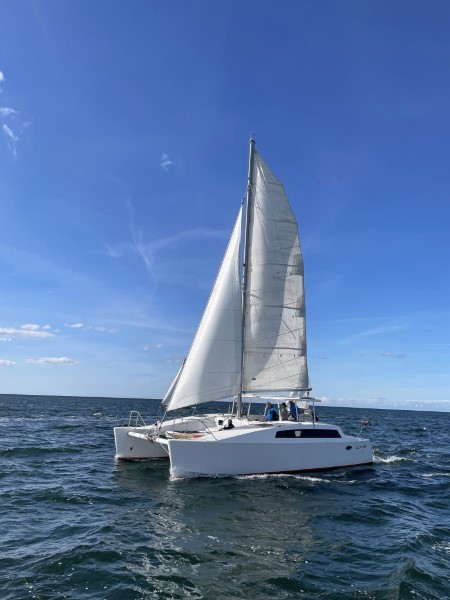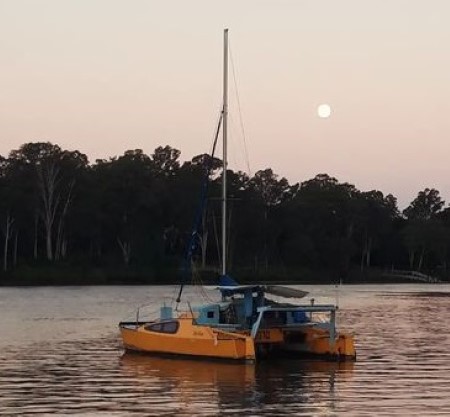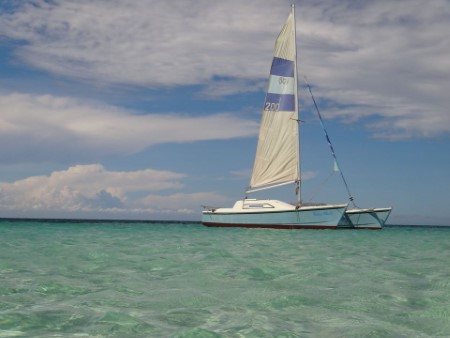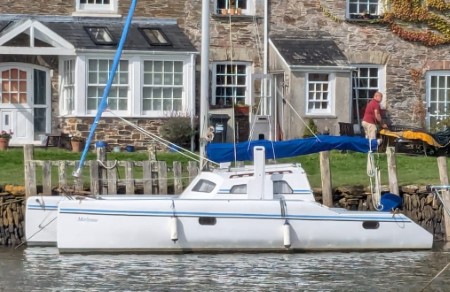One of my favourite questions is "when did you last drive a car with wooden seats?" A 3hour car ride is a long trip, but only one short watch when sailing. So helm comfort should really be a priority.
Check out this first photo, ignore the fact that there doesn't appear to be anything stopping the helm falling overboard backwards. Just imagine standing like that, even for an hour, possibly for a full night watch in bad weather.

To be honest, having said that, we hadn't given helm position enough thought until we started developing our 30ft Sagitta catamaran in the late 1980s. We went to a boat show and studied all the powerboats, reasoning that they would emphasise comfort and convenience more than sail boats. And we were right, we gathered a lot of ideas that we were able to incorporate into our newer designs.
Other designers don't seem to have followed the powerboat lead. For example the Leopard 44 that I sailed to the Bahamas had a very uncomfortable helm seat. The Lagoon 380 that I sailed across the Atlantic was better, but I couldn't see the compass from the helm, never mind have a good view of all four corners of the boat. Puzzling, as it's simple enough to design a comfortable chair - after all, everyone has one at home.
One complication with a sailing boat, especially one that is tiller steered, is that you really need two comfortable seating positions. One when actually steering and the other when under autopilot, or when socialising in the cockpit apres sail.
You can see a short video clip shows Sagitta's original helm seating area when in autopilot mode here https://www.youtube.com/watch?v=fwnJUyGnZAo
When actually steering the helm sat on the top of the foam backrest. That worked well for a while, but the round tubing quickly cut through the foam cushion and it became uncomfortable.
So later designs kept the same concept, except that the back rest and top was padded plywood, as seen on Eclipse in the this photo. And note the parasol instead of a bimini. This worked extremely well, even in the tropics. It allowed a good view of the sails, made it easy to reef the mainsail and could be "tacked" from side to side as needed.

Bringing the helm seat design right up to date, when I refitted the same Sagitta, now 34 years old, I designed what I think is the best solution - a sliding seat back. All very simple, made in plywood.
The original lower seating position was slatted wood and shaped like a park bench. That worked well but was unnecessarily long. So it's now shorter with a useful shallow locker under. The seat swivels so that when steering you sit high with a good view over the cabin top and with full control. Then, with a flick of the wrist, the seat becomes a back rest for use when under autopilot.


The photos show the two states and the video here https://www.youtube.com/watch?v=X_z6jz_-cqM shows how quick it is to go from one position to the other. A further refinement is to have a waterproof tablet chart plotter on a bracket (normally used on a bike) so the chart is literally in one's face when steering. The final refinement is of course cockpit cushions, not shown in these photos.

The last few posts have all been "me, me, me", so now it's time to post some recent photos and comments of my home built catamaran designs sailing all over the world.
Next is a really nice Mirage, now sailing in Estonia, although it was built in Panama about 15 years ago and then sailed singlehanded across the Atlantic to the UK. After buying it Julia did a major restoration and it now looks like new.
Then an even older boat, this time a heavily modified Janus. Normally an open-deck boat, the original owners added a bridgedeck cabin and it was launched in the early 1990's. After various owners Brad has given it a new lease of life and is cruising the east coast Australia, often for weeks at a time.
https://www.facebook.com/bradlestix/
Not a home build, but a Strider Club that was built by Palamos Boatbuild in the UK in 1989. Still with the original owners it's still sailing in Tanzania, east Africa. Seen here anchored at Nyule sandbank off Tanga Bay.
Although the Strider Club has ceased production you can still build your own, it's called Shadow
And finally, and again built nearly 20 years ago, this very nice Wizard. A bit closer to home, I photoed it on one of our Chat trips as it's moored in St Germans, near the head of the Lynher river.
There are two places to visit for those who want to contact owners directly. The first is my forum, which you can access here:
and the second is the Richard Woods Catamarans FB page, run, not by me, but by owners. See here:
Sagitta is now ashore for the winter (lots more jobs to do!), the photo below shows it stropped, ready to lift out, at the Multihull Centre, Millbrook.

As I motored up to the pontoon I passed Uhuru, a Windsong built in exterior (not marine grade) plywood 40 years ago, by one of our very first customers. It was built on a tiny budget as the builder had lost his previous, sadly uninsured, multihull. Nevertheless it made two Atlantic crossings, one singlehanded.

The new owner says it's in really good condition and is looking forward to better weather so he can get out cruising.
Probably prompted by my recent post, I just received the following note from an Australian Gypsy owner
"Just thought I'd pass on a photo of our time on our 20 year old 28ft Gypsy.
We sailed as a family of 3 with our boy being 15months old at the start of our journey. We departed sailed her from Brisbane to just north of Townsville, far north Queensland, over a period of 5 months.
The Gypsy turned out to have the perfect layout for a young child, as it provided secure holding the entire way around the boat. The main cabin proved to be the perfect play room on long passages and while at anchor. We had enough space to store our gear and provisions for 3 weeks at a time if needed.
At one point we had a 10 day trip with 4 adults and 2 children. The separated hulls provided the perfect opportunity to have our own living spaces when we felt we needed a "break" from each other."
Another Gypsy was home built in plywood in Panama. Some years ago it sailed to Tahiti and is now in Fiji. Proving once again that the Gypsy truly is a "Budget Ocean Cruiser"
Way back in the mid 1980s we designed two very similar 35ft catamarans. The performance cruiser Banshee and the family cruiser Flica. It was then many years before I drew the 34ft Vardo, which is a compromise between those two earlier designs.
The Vardo has the performance rig of the Banshee coupled with the standing headroom throughout and all round vision from the saloon of the Flica. It has a big galley and heads compartment yet is still able to sleep 8 in 4 double cabins.
A number have been built in the last 10 years.
One of the first home builds was launched in St Augustine, Florida and which was then sailed through the Caribbean, Panama Canal, across the Pacific to New Zealand and finally to Australia - all with a young family on board. The owners are delighted with the boat, for example:
"Arrived Georgetown, Bahamas yesterday. A front had come through resulting in 5-6 foot seas straight down the rhumb line, but with wind at about 30 degrees off the seas. Sustained high twenty knots with some gusts to near 35.
With a double reefed main and 80% jib we hit 16.5 knots. More would have been possible with someone trimming the sails when the apparent moved forward and could have at least handled one less reef and the full jib. The kids were happily playing in the saloon looking out the windows."
A Philippines owner wrote "Thanks for designing a great Catamaran. I would recommend your designs to anyone and appreciate your support! She is a great compromise between performance, comfort and design safety."
And then the project that prompted this post. A grp Vardo is being professionally built in Poland, the hull and some deck moulds were made. The builder is currently looking for new customers. Please contact me in the first instance and I will forward your contact details to the builder. See photos and the very impressive 3D sketches.
As many of you know, I built the prototype Gypsy 28 catamaran on a very tight budget back in 1996. I cruised it for a few years and sold it when I built my Eclipse 32 in 2001.
Since then it has had a checkered history, indeed, it was almost abandoned for a few years. Fortunately it was eventually sold to someone who has been cruising it far and wide. Again not without incident, as it was hit by a fishing boat off Morocco.
So I was delighted to get the attached photo and comments a couple of days ago. In fact I was sent several photos from different people - S. Portugal is obviously a mecca for those who sail multihulls that can easily dry out and who want to escape northern Europe winters.
"Yesterday I had the opportunity to talk briefly with Gypsy's owner on the beach. He confirmed that she was yours. He's very nice and proud to be the owner of this particular cat, and very happy with the performance. After complicated covid years, he's now planning to do some long distance sailing, maybe going to spend the winter in the Canary Islands"
I just received this email from a Norwegian builder:
"I've completed the construction of my Sango "Rán" on Jeløya, Norway.
It took me three years to finish this project. The construction proved to be quite challenging at times, yet I found immense satisfaction in every aspect of it. I acquired a lot of knowledge and skills throughout the experience.
My building space was a garage with a 15-meter driveway, measuring 2.60 meters in width. While it served its purpose for me, I wouldn't necessarily recommend it. I divided the boat's assembly into four parts: the Cockpit/Cuddy, floats, and beams. The Cockpit/Cuddy section was lifted with the trailer structure, and I used a winch to position the floats underneath. I then inserted and epoxied the beams into their designated locations.
A few weeks ago, I successfully launched Rán, and the floats folded out seamlessly. Sango is spacious enough for a family of four and will serve us well for many years.
Thank you for enabling regular people like me to build a catamaran."
You can see more on the Sango here:
The south coast of Devon and Cornwall is one of the major English cruising areas. Lots of safe all weather harbours and no outlying dangers - apart from the well marked Eddystone and Wolf rocks.
Just west of Start Point is Salcombe and about 20 miles SE of my home port of Plymouth. So it is surprising that I hadn't sailed there for maybe 40 years. Fortunately last weekend's forecast was for light NW winds switching the next day to a light SE wind. Perfect for a broad-reach there and back. Furthermore the tide was good and, surprisingly, for late September, it was going to be warm and sunny.
We left our mooring on Sagitta about 11am, with more wind than forecast and also with a lumpy sea, left over from the previous days gale. No matter, as we were reaching down the coast.
I have never fully understood why, but the shoreline from Bolt Tail to Salcombe seems to produce steeper waves than normal. I assume because the swells bounce back from the steep shore. They extend some way out, so its always worth staying at least a mile offshore.
As soon as we had cleared Plymouth breakwater the auto pilot was put on and then, as they say, we "sat back, relaxed and enjoy the trip"
We had wanted to go all the way up to Kingsbridge, but the harbour master wasn't sure if there'd be room, so that's for another time - hopefully before 2063!
I'd forgotten how fast the tide runs in the mooring field off Salcombe town. Another reason for going further up the harbour towards Kingsbridge. And that same tide makes crossing the entrance bar very dangerous, in fact impossible, in a strong southerly wind. Even in the light conditions we had overnight the swell was noticeable.
It took 4 hours to get to Salcombe, but sailing home was quicker. We crossed Salcombe bar at 9am, were off Plymouth breakwater by 11 and having lunch on our mooring by 12.15.
Fortunately, after a lot of work in the spring and early summer, Sagitta is much more habitable than it was a year ago, so we are enjoying living on board. One major job still outstanding is to replace the saloon sidelining. Foam backed vinyl has a nominal 15 year life, Sagitta's is over 30!, so no wonder it's falling down in places. Just another winter job to add to the, once again, growing list.
You can see more on Sagitta here:
Not surprisingly, my most popular design is my 8ft yacht tender Crayfish, designed over 40 years ago and built from 3 sheets 4mm (3/16in) plywood. A very easy build, indeed we once built one on the marina pontoon next to our boat.
I just received an email from a Crayfish enthusiast. I say that as he has built 9 of them! He is also a very experienced multihull sailor having sailed his trimaran over 50,000 miles round the Pacific over the last 35 years. In his email he wrote "....The reason I’m writing to you now is that I just posted a little video
of the construction of two sailing Crayfish, that I built for the Royal Belau Yacht Club in Koror, Palau. Knowing that they would be used to teach sailing to kids, I built them solid, all 1/4” ply, and with two water tight compartments. The video shows it all. Thank you Richard, such a practical dinghy design. Love all your multihull designs as well...."














































